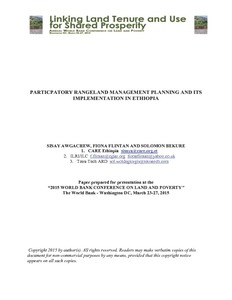Resource information
The pastoral and agro-pastoral areas of Ethiopia cover around 65% of the country’s surface area. Rangeland resources are managed under collective common property arrangements, which are increasingly coming under pressure from both internal and external forces of change including alternative, but not necessarily ‘appropriate’, land uses. Thus it has become imperative to more formally recognise and protect customary rangeland management institutions and arrangements, bearing in mind that there may be a need for some adaptation to current and future socio-economic, environmental and political contexts. In response, a process of participatory rangeland management (PRM) has been developed, both to improve the management of rangeland resources and their security of access for local rangeland users. The USAID-funded PRIME project has played a key role in this development, up-scaling the approach across pastoral areas in Oromia, Afar and Somali regional states. This paper describes the experience of PRIME with PRM, the challenges faced and opportunities arising. It concludes by discussing the relevance of PRM as an approach for improving the management of and security of access to rangeland resources in Ethiopia, and beyond.



